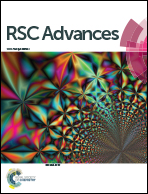Polydopamine nanotubes-templated synthesis of TiO2 and its photocatalytic performance under visible light†
Abstract
Herein, we demonstrated that an efficient TiO2 visible-light photocatalyst can be fabricated by templating mesoporous polydopamine (PDA) nanotubes. Because PDA is a nitrogen-doped carbon source, PDA nanotubes as templates elicited distinct advantages for obtained mesoporous TiO2. First, they introduced a codopant of carbon and nitrogen into anatase TiO2 that narrowed its band gap. Second, they could be graphitized in an optimized calcination process to form graphene-like carbon layers on TiO2 surfaces with high conductivity, which assisted the separation of photogenerated electron–holes of TiO2. These features endow TiO2@C-PDA (400-2) excellent photocatalytic performance for the degradation of methyl orange under visible-light irradiation (>420 nm).



 Please wait while we load your content...
Please wait while we load your content...